- Home Page
- Better Kites
- ... Sode Kite
How to Make a Sode Kite
Step by Step—Page 1 of 4
The MBK Dowel Sode
This set of instructions on how to make a sode kite assumes you know absolutely nothing about kite making. You might already have some
of the simple tools and materials required.
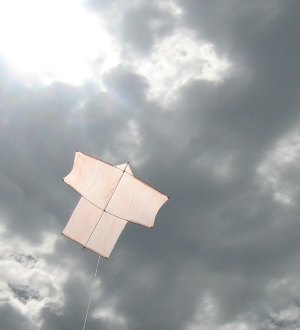 MBK Dowel Sode
MBK Dowel SodeAnything you don't have is easily bought. If it's not exactly what I used, then at least something pretty similar!
The Dowel Sode is a large tailless design based on the traditional Japanese kite. Like the other Japanese design in this series, the rokkaku, this kite is a light-to-moderate-wind flier. However, it can take a little more wind strength than the rok.
The sode scoots around the sky in very gusty moderate winds. In smoother and lighter winds, it is a very efficient and steady flier.
Setting up on the flying field is just a matter of attaching the bow line toggles to put some curvature into both the horizontal spars. Also, the upper bow-line is connected to the nose of the kite and the lower bow-line connects to the tail. Thus the horizontal spars are tensioned away from each other.
Then, when the flying line is attached to the bridle, you are ready to launch! The method of attachment is illustrated further down this page.
I have chosen to make "One Dowel Length" equal to 120 cm for every kite in the Dowel Series. If you are in North America, 48 in. of 3/16 in. dowel is close enough to 120 cm of 5 mm dowel. This will result in a kite with similar flying characteristics to my original. Make sure to find a hardwood type for your dowel.
On this site, there's more kite-making info than you can poke a stick at. :-)
Want to know the most convenient way of using it all?
The Big MBK E-book Bundle is a collection of downloads—printable PDF files which provide step-by-step instructions for many kites large and small.
That's every kite in every MBK series.
How to Make a Sode Kite
Sail
Now's the time to read up on the kite making tools and materials required for making a Dowel Sode, if you haven't already.
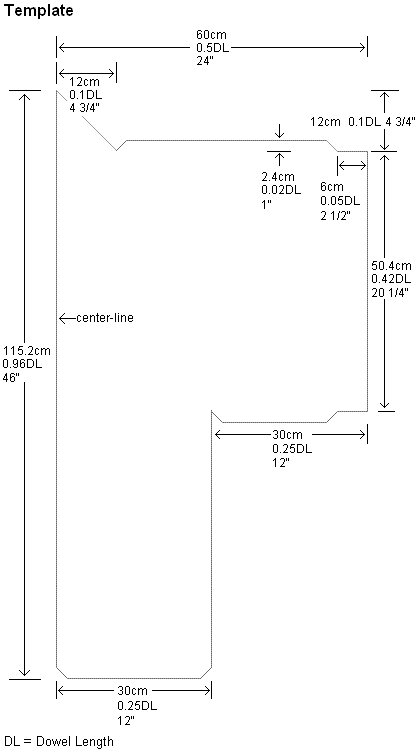
The template shown above represents one side of the kite sail. You will now transfer these measurements to the sail plastic.
Like to see a video clip? Just scroll down to near the end of this page.
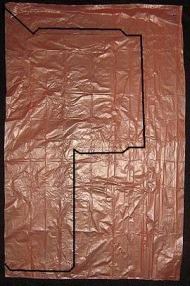
- First, take a large bag that you want to use for the sail, and lay it flat on the floor.
- Mark dots on the plastic that correspond to the corners of the template. There is no need to use a T-square or an extra-long ruler, since any small errors in position will be duplicated on the other side of the sail.
- Using the marking pen, rule lines between the dots as in the photo. For lines longer than the ruler, just add a few extra dots using one of the dowel spars as a ruler! Then it's easy to connect the dots with a ruler. It's probably best not to rule the whole line with the dowel, since it bends easily.
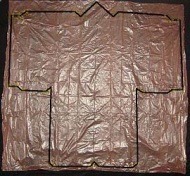
- Flip the plastic bag over, and trace over all the black lines using your marker pen and ruler.
- Cut
out a rectangular section of the bag containing the kite sail, open it
out and lay it flat on the floor; you can now see the complete sail outline as in the photo.
When doing the following, most of the width of the tape should be inside the kite's outline. Use a single length of tape for each line. Hold it out straight; touch it down to the plastic at one end then at the other end; dab it down in the middle then press down all along its length.
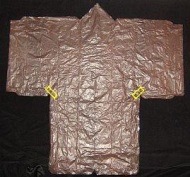
- Lay clear sticking tape along all the lines, letting it overlap at the corners.
- With scissors, cut along all the black lines. This will leave most of the width of the sticking tape inside the sail outline. See the photo.
- Where indicated by the yellow rectangles, reinforce those two corners with extra sticking tape—on both sides of the plastic for extra strength!
As mentioned earlier, there's more kite making on this site than you can poke a stick at. :-)
Want to know the most convenient way of using it all?
The Big MBK E-book Bundle is a collection of downloads—printable PDF files which provide step-by-step instructions for many kites large and small.
That's every kite in every MBK series.
